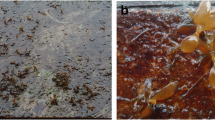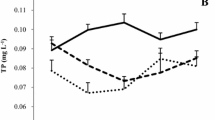Abstract
The uptake of nitrogen (N) by waterhyacinth (Eichhornia crassipes) was maximal when the culture solution contained a combination of 36 ppm N and 6,53 ppm phosphorus (P). N uptake was inhibited by increasing P or decreasing N in the culture medium. Uptake of P was stimulated by the elevation of either N or P or both. An increase of P above O ppm inhibited the accumulation of N. Similarly, the accumulation of P was enhanced by increasing levels of P but was reduced with increasing levels of N. Both N and P levels were always greatest in leaves; next highest in floats and lowest in roots. High tissue levels of these two nutrients and the capacity for nutrient removal from water by waterhyacinth indicates a possible role for this plant in the reduction of eutrophication in nutrient polluted waters as well as the use of harvested, dried tissue for fertilizer.
Similar content being viewed by others
References
Boyd, C. E. & Vickers, D. H., 1971. Variation in the elemental content of Eichhornia crassipes. Hydrobiologia 38: 409–414.
Bremner, J. M., 1960. Determination of nitrogen in soil by the Kjeldahl method. J. Agric. Sci. 55: 1–23.
Chadwick, M. J. & Obeid, M., 1966. A comparative study of the growth of Eichhornia crassipes and Pistia stratiotes in water culture. J. Ecol. 54: 563–575.
Dunigan, E. P., Phelan, R. A. & Shamsudden, Z. H., 1975. Use of waterhyacinths to remove nitrogen and phosphorus from eutrophic waters. Hyacinth Control J. 13: 59–61.
Haller, W. T. & Sutton, D. L., 1973. Effect of pH and high phosphate concentrations on growth of waterhyacinth. Hyacinth Control J. 11: 59–61.
Hoagland, D. R. & Arnon, D. I., 1950. The water-culture method for growing plants without soil. California Agric. Exptl. Station, Circular 347.
Mitsch, W. J., 1977. Waterhyacinth (Eichhornia crassipes) nutrient uptake and metabolism in a north central Florida marsh. Arch. Hydrobiol. 81: 188–210.
Ornes, W. H. & Sutton, D. L., 1975. Removal of phosphorus from static sewage by waterhyacinth. Hyacinth Control J. 13: 56–59.
Ower, J., Cresswell. C. F. & Bate, G. C., 1980. Effects of varying levels of culture nitrogen and phosphorus on the growth and form of waterhyacinth. Manuscript in preparation.
Paech, K. & Tracey, M. V., 1957. In: Modern methods of plant analysis II p. 487. Springer Verlag. Berlin.
Wolverton, R. & McDonald, R. C., 1961. Don't waste waterweeds. New Scientist 12: 318–320.
Author information
Authors and Affiliations
Rights and permissions
About this article
Cite this article
Ower, J., Cresswell, C.F. & Bate, G.C. The effects of varying culture nitrogen and phosphorus levels on nutrient uptake and storage by the waterhyacinth Eichhornia crassipes (Mart) Solms. Hydrobiologia 85, 17–22 (1981). https://doi.org/10.1007/BF00011341
Received:
Published:
Issue Date:
DOI: https://doi.org/10.1007/BF00011341




